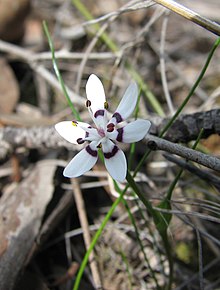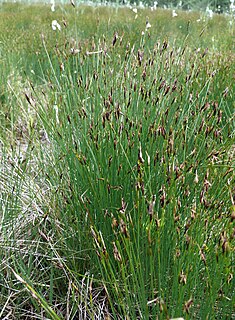| Wurmbea | |
|---|---|
 | |
| Wurmbea dioica in Paddys Ranges State Park, Australia | |
| Scientific classification | |
| Kingdom: | Plantae |
| Clade: | Tracheophytes |
| Clade: | Angiosperms |
| Clade: | Monocots |
| Order: | Liliales |
| Family: | Colchicaceae |
| Genus: | Wurmbea Thunb. |
| Species | |
See text | |
| Synonyms | |
| |



Wurmbea is a genus of perennial herbs in the family Colchicaceae, native to Africa and Australia. There are about 50 species, with about half endemic to each continent.
Recently the circumscription of the genus Wurmbea has been increased to include Onixotis punctata and Onixotis stricta. [1]
African species accepted by the World Checklist of Selected Plant Families as of January 2015 [update] are: [2] [3]
- Wurmbea angustifolia B.Nord. – E. Zimbabwe to S. Africa
- Wurmbea burttii B.Nord. – Lesotho to KwaZulu-Natal
- Wurmbea capensis Thunb. – S.W. Cape Province
- Wurmbea compacta B.Nord. – S.W. Cape Province
- Wurmbea dolichantha B.Nord. – W. Cape Province
- Wurmbea elatior B.Nord. – S. Africa
- Wurmbea elongata B.Nord. – S.W. Cape Province
- Wurmbea glassii (C.H.Wright) J.C.Manning & Vinn. – S. Cape Province
- Wurmbea hiemalis B.Nord. – S.W. Cape Province
- Wurmbea inusta (Baker) B.Nord. – S.W. Cape Province
- Wurmbea kraussii Baker – S. Africa
- Wurmbea marginata (Desr.) B.Nord. – S.W. Cape Province
- Wurmbea minima B.Nord. – S.W. Cape Province
- Wurmbea monopetala (L.f.) B.Nord. – S.W. Cape Province
- Wurmbea punctata (L.) J.C.Manning & Vinn. – S.W. Cape Province
- Wurmbea pusilla E.Phillips – Lesotho to KwaZulu-Natal
- Wurmbea recurva B.Nord. – S.W. Cape Province
- Wurmbea robusta B.Nord. – S.W. Cape Province
- Wurmbea spicata (Burm.f.) T.Durand & Schinz – Cape Province
- Wurmbea stricta (Burm.f.) J.C.Manning & Vinn. – Cape Province
- Wurmbea tenuis (Hook.f.) Baker – Tropical & S. Africa
- Wurmbea variabilis B.Nord. – Cape Province
Australian species accepted by the World Checklist of Selected Plant Families as of January 2015 [update] are: [2]
- Wurmbea australis (R.J.Bates) R.J.Bates – South Australia
- Wurmbea biglandulosa (R.Br.) T.D.Macfarl. – S.E. Queensland to SE. Australia
- Wurmbea calcicola T.D.Macfarl. – S.W. Australia
- Wurmbea centralis T.D.Macfarl. – Central & S. Australia
- Wurmbea cernua T.D.Macfarl. – S. Western Australia
- Wurmbea citrina (R.J.Bates) R.J.Bates – S.E. Australia
- Wurmbea decumbens R.J.Bates – South Australia (Eyre Peninsula)
- Wurmbea densiflora (Benth.) T.D.Macfarl. – Western Australia
- Wurmbea deserticola T.D.Macfarl. – W. & Central Australia
- Wurmbea dilatata T.D.Macfarl. – W. Western Australia
- Wurmbea dioica (R.Br.) F.Muell. – S.W. & S.E. Australia
- Wurmbea drummondii Benth. – S.W. Australia
- Wurmbea fluviatilis T.D.Macfarl. & A.L.Case – N.W. Western Australia
- Wurmbea graniticola T.D.Macfarl. – S.W. Australia
- Wurmbea inflata T.D.Macfarl. & A.L.Case – W. Central Western Australia
- Wurmbea inframediana T.D.Macfarl. – W. Western Australia
- Wurmbea latifolia T.D.Macfarl. – S.E. Australia
- Wurmbea monantha (Endl.) T.D.Macfarl. – W. & S.W. Western Australia
- Wurmbea murchisoniana T.D.Macfarl. – W. Western Australia
- Wurmbea nilpinna R.J.Bates – South Australia
- Wurmbea odorata T.D.Macfarl. – W. Western Australia
- Wurmbea pygmaea (Endl.) Benth. – WS.W. Western Australia
- Wurmbea saccata T.D.Macfarl. & S.J.van Leeuwen – N.W. Western Australia
- Wurmbea sinora T.D.Macfarl. – S.W. & S. Western Australia
- Wurmbea stellata R.J.Bates – South Australia
- Wurmbea tenella (Endl.) Benth. – Western Australia
- Wurmbea tubulosa Benth. – WS.W. Western Australia
- Wurmbea uniflora (R.Br.) T.D.Macfarl. – S.E. Australia












